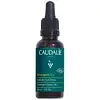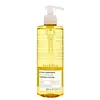What's inside
What's inside
 Key Ingredients
Key Ingredients

 Benefits
Benefits

 Concerns
Concerns

 Ingredients Side-by-side
Ingredients Side-by-side

Caprylic/Capric Triglyceride
MaskingVitis Vinifera Seed Oil
EmollientPrunus Amygdalus Dulcis Oil
Skin ConditioningRosa Canina Fruit Oil
EmollientCitrus Aurantium Amara Leaf/Twig Oil
MaskingLinalool
PerfumingDaucus Carota Sativa Seed Oil
EmollientHelianthus Annuus Seed Oil
EmollientSantalum Album Oil
MaskingTocopherol
AntioxidantCitrus Aurantium Amara Flower Oil
MaskingLavandula Angustifolia Oil
MaskingGeraniol
PerfumingLimonene
PerfumingCitral
PerfumingFarnesol
PerfumingCaprylic/Capric Triglyceride, Vitis Vinifera Seed Oil, Prunus Amygdalus Dulcis Oil, Rosa Canina Fruit Oil, Citrus Aurantium Amara Leaf/Twig Oil, Linalool, Daucus Carota Sativa Seed Oil, Helianthus Annuus Seed Oil, Santalum Album Oil, Tocopherol, Citrus Aurantium Amara Flower Oil, Lavandula Angustifolia Oil, Geraniol, Limonene, Citral, Farnesol
Water
Skin ConditioningGlycerin
HumectantPropanediol
SolventButylene Glycol
HumectantOleth-20
CleansingMethyl Gluceth-20
HumectantSodium PCA
HumectantPhenoxyethanol
PreservativeCamellia Sinensis Leaf Water
MaskingCaprylyl Glycol
EmollientGlycine Soja Oil
EmollientTocopherol
AntioxidantDisodium EDTA
Limonene
PerfumingPEG-6 Isostearate
EmulsifyingHexyl Cinnamal
PerfumingLinalool
PerfumingCitrus Aurantium Amara Flower Oil
MaskingCitral
PerfumingHesperetin Laurate
AntioxidantParfum
MaskingWater, Glycerin, Propanediol, Butylene Glycol, Oleth-20, Methyl Gluceth-20, Sodium PCA, Phenoxyethanol, Camellia Sinensis Leaf Water, Caprylyl Glycol, Glycine Soja Oil, Tocopherol, Disodium EDTA, Limonene, PEG-6 Isostearate, Hexyl Cinnamal, Linalool, Citrus Aurantium Amara Flower Oil, Citral, Hesperetin Laurate, Parfum
Ingredients Explained
These ingredients are found in both products.
Ingredients higher up in an ingredient list are typically present in a larger amount.
Citral is a fragrance and used to add a lemon-like scent to products. It is both naturally found in plants and created synthetically. In plants, it is commonly occurring in lemon myrtle, lemongrass, lemon tea-tree, lemon verbena, and other citruses.
The EU mandates Citral be listed separately as a fragrance. It is a known allergen and may cause contact dermatitis. Citral can also used as a masking ingredient.
The term 'fragrance' is not regulated in many countries. In many cases, it is up to the brand to define this term. For instance, many brands choose to label themselves as "fragrance-free" because they are not using synthetic fragrances. However, their products may still contain ingredients such as essential oils that are considered a fragrance.
The term 'citral' is a collective term for two geometric isomers: geranial/Citral A and neral/Citral B.
Learn more about CitralCitrus Aurantium Amara Flower Oil is the volatile oil obtained from the flowers of the Bitter Orange, Citrus aurantium L. var. amara L., Rutaceae
Limonene is a fragrance that adds scent and taste to a formulation.
It's found in the peel oil of citrus fruits and other plants such as lavender and eucalyptus. The scent of limonene is generally described as "sweet citrus".
Limonene acts as an antioxidant, meaning it helps neutralize free radicals.
When exposed to air, oxidized limonene may sensitize the skin. Because of this, limonene is often avoided by people with sensitive skin.
The term 'fragrance' is not regulated in many countries. In many cases, it is up to the brand to define this term. For instance, many brands choose to label themselves as "fragrance-free" because they are not using synthetic fragrances. However, their products may still contain ingredients such as essential oils that are considered a fragrance.
Learn more about LimoneneLinalool is a fragrance and helps add scent to products. It's derived from common plants such as cinnamon, mint, citrus, and lavender.
Like Limonene, this ingredient oxidizes when exposed to air. Oxidized linalool can cause allergies and skin sensitivity.
This ingredient has a scent that is floral, spicy tropical, and citrus-like.
Learn more about LinaloolTocopherol (also known as Vitamin E) is a common antioxidant used to help protect the skin from free-radicals and strengthen the skin barrier. It's also fat soluble - this means our skin is great at absorbing it.
Vitamin E also helps keep your natural skin lipids healthy. Your lipid skin barrier naturally consists of lipids, ceramides, and fatty acids. Vitamin E offers extra protection for your skin’s lipid barrier, keeping your skin healthy and nourished.
Another benefit is a bit of UV protection. Vitamin E helps reduce the damage caused by UVB rays. (It should not replace your sunscreen). Combining it with Vitamin C can decrease sunburned cells and hyperpigmentation after UV exposure.
You might have noticed Vitamin E + C often paired together. This is because it is great at stabilizing Vitamin C. Using the two together helps increase the effectiveness of both ingredients.
There are often claims that Vitamin E can reduce/prevent scarring, but these claims haven't been confirmed by scientific research.
Learn more about Tocopherol